Frock Coats today?
Hello Everyone, I'm new here and not very expertise on the topic. Some background information about me may be useful: I'm Spanish (from Spain, don't think "Latin America" that is Hispanic if anything, to avoid confusion I'm a Spaniard). I'm 17 years old but not one of those who only want to know a bunch of things for his prom suit (there is no such thing in Spain as 'prom dance'). I'm 1.83 tall (6.0 feet I think?) and weight 59kg.
I want to have a bespoke frock coat done for me, a formal one. Up to what I know, frock coats have technically disappeared even as formal wear. So I guess it must be difficult to find a tailor who can make them nowadays and who can make them well. I think the frock coat is a perfect kind of coat for me, my body form (long arms, thin waist, not very deep (I'm referring with 'deep' to the dimension from my back to the front of my chest), well-proportioned shoulders (I don't know how to make say this better, sorry, I mean they have a perfect look in length in relation to my head), long neck, and my weight and height...) and how I move my body. I think it can emphasize on my good height but also (with the double breasting) compensate my weight for a well-balanced look. Before anything I'd like some feedback on whether I'm right here, if you think the frock coat isn't such a good option please tell me. When/where am I going to use the frock coat? Well, for some formal occasions, and some occasions of personal choice to wear it.
Now, I would like to know if any of you know of any tailor who can make good frock coats today, please. It doesn't matter if it is in the states, in UK or the rest of Europe. Thank you in advance for the time and help.
I want to have a bespoke frock coat done for me, a formal one. Up to what I know, frock coats have technically disappeared even as formal wear. So I guess it must be difficult to find a tailor who can make them nowadays and who can make them well. I think the frock coat is a perfect kind of coat for me, my body form (long arms, thin waist, not very deep (I'm referring with 'deep' to the dimension from my back to the front of my chest), well-proportioned shoulders (I don't know how to make say this better, sorry, I mean they have a perfect look in length in relation to my head), long neck, and my weight and height...) and how I move my body. I think it can emphasize on my good height but also (with the double breasting) compensate my weight for a well-balanced look. Before anything I'd like some feedback on whether I'm right here, if you think the frock coat isn't such a good option please tell me. When/where am I going to use the frock coat? Well, for some formal occasions, and some occasions of personal choice to wear it.
Now, I would like to know if any of you know of any tailor who can make good frock coats today, please. It doesn't matter if it is in the states, in UK or the rest of Europe. Thank you in advance for the time and help.
Dear Guille,
I think I know a very learned member who will be very happy to help you with a lot of information Just wait and see, he will show up!
Just wait and see, he will show up!
On one hand you appear to realize that "frock coats have technically disappeared even as formal wear". On the other hand, you ask (or wonder?) "When/where am I going to use the frock coat?". You are guaranteed to make a conspicuous appearance anywhere you go wearing a frock coat these days (and I mean ANYwhere). It will be a very strong differentiating statement. Have you considered these aspects, too - beyond the visually appealing projected image of yourself wearing such a grand garment?
I think I know a very learned member who will be very happy to help you with a lot of information
On one hand you appear to realize that "frock coats have technically disappeared even as formal wear". On the other hand, you ask (or wonder?) "When/where am I going to use the frock coat?". You are guaranteed to make a conspicuous appearance anywhere you go wearing a frock coat these days (and I mean ANYwhere). It will be a very strong differentiating statement. Have you considered these aspects, too - beyond the visually appealing projected image of yourself wearing such a grand garment?
Hi. I see how I might have sound quite absurd there. My idea is to wear the frock coat on formal occasions (weddings, etc) where the dressing code isn't very much defined, which is most common today. Sometimes in a wedding the groom and inner circle wear morning coats, and the rest (most) of the people wear regular lounge suits maybe strollers. That would be the type of occasion. The reasons why I think I will be using the frock coat even though it has disappeared are 1) people don't know/follow very well the dress codes, thus leaving space for me to choose a frock coat in some cases (of course not in all cases: not to an evening event, for example), 2) as I'm very young people don't really expect you to follow the line of the rest and look a kind, so sometimes you just wear a blazer not even a suit, well instead of that I prefer a frock coat, 3) in Spain people care even less about dress codes specially if its for family/friends only events, and 4) sometimes I'll wear the frock coat for the simple reason of wearing it; wasn't it supposed to be everyday wear, for work? well some days which aren't special, I'll just wear them, to university when I get there or on free days for any activity not requiring much movement.Costi wrote:Dear Guille,
I think I know a very learned member who will be very happy to help you with a lot of informationJust wait and see, he will show up!
On one hand you appear to realize that "frock coats have technically disappeared even as formal wear". On the other hand, you ask (or wonder?) "When/where am I going to use the frock coat?". You are guaranteed to make a conspicuous appearance anywhere you go wearing a frock coat these days (and I mean ANYwhere). It will be a very strong differentiating statement. Have you considered these aspects, too - beyond the visually appealing projected image of yourself wearing such a grand garment?
Welcome to the forum Guille. I was surprised I overlooked this thread as I have an interest in historic dress. You may have already read my Wiki article on the subject of frock coats:
http://en.wikipedia.org/wiki/Frock_coat
I certainly admire anyone who shares an interest in reviving certain garments of great elegance. I have thoroughly researched the subject of having a frock coat made for myself and have considered all that it involves very carefully. That said, I have yet to commission one for myself. Just as I always swear that I will buy a high end turntable, I always end up living with my CD player, for practical reasons.
My recommendation is that at your age you are better off looking on eBay for a vintage/antique frock coat in good condition. However, your proportions are going to make life very difficult. The average height of men a 100 years ago was less than it is now. Deutsche eBay often has them (look under Gehrock).
What I would like to encourage you to avoid is ending up with a cheap and costumey replica done by a dodgy tailor. You would be much better off getting a good morning coat or a stroller. Frock coats are a type of coat known as a body coat. Few tailors these days know how to make a good body coat any more. A frock coat will require at least twice the amount of work that a normal lounge style coat takes - and you will be charged accordingly. The ability to cut a good frock was the ultimate test for a tailor in the old days. That said, I am sure someone like Rubinacci (Naples) would be able to make one. Rubinacci keep a stock of vintage fabrics and you may even find a fabric which Italian tailors call 'castor' in there, which is a traditional fabric for frock coats. In any case, you will need to seek out the finest tailors in Europe to be able to have confidence in their ability to live up to the challenge. Many tailors (if they are honest) will refuse your commission. You are looking at a bill of several thousand euros and multiple trips for fittings. If you really want, I can provide tailors patterns, pictures and fashion plate illustrations that a tailor could use to draught a pattern.
The subject of tailors in Spain (at least Madrid) has been discussed elsewhere and your options are somewhat limited from what I understand. So you would have to travel to Savile Row or Italy.
The next thing is that you are best advised to leave the commission of something really difficult such as a frock coat until after your tailor has got your pattern for a lounge coat right. In other words, you really ought to have a test run of a couple of sport coats or lounge suits before you ask your tailor to make a body coat. You will get a lot more wear out of a these garments anyway.
At this point, you have to ask yourself whether you are really that committed to commission such a garment. I commend you for sharing a fascination for a lost world of elegance. Frock coats were an expensive affair affordable only to gentlemen, back in the 19th century and things have hardly gotten any easier today.
So, once again, it is like having a passion for high end turntables. You need a lot of commitment and financial resources to achieve it. But if you are going to buy a dreadfully cheap and scratchy turntable, you are better off just going for a reasonably priced CD player.
Sorry if I am pouring cold water on your dreams. But keep dreaming away and one day you might just manage to realise them. Though, if you have really rich parents and you can afford to make regular trips to Rubinacci then I will provide much more detailed guides that Mario Rubinacci or some Savile Row tailor will find useful to guide him on style and construction.
http://en.wikipedia.org/wiki/Frock_coat
I certainly admire anyone who shares an interest in reviving certain garments of great elegance. I have thoroughly researched the subject of having a frock coat made for myself and have considered all that it involves very carefully. That said, I have yet to commission one for myself. Just as I always swear that I will buy a high end turntable, I always end up living with my CD player, for practical reasons.
My recommendation is that at your age you are better off looking on eBay for a vintage/antique frock coat in good condition. However, your proportions are going to make life very difficult. The average height of men a 100 years ago was less than it is now. Deutsche eBay often has them (look under Gehrock).
What I would like to encourage you to avoid is ending up with a cheap and costumey replica done by a dodgy tailor. You would be much better off getting a good morning coat or a stroller. Frock coats are a type of coat known as a body coat. Few tailors these days know how to make a good body coat any more. A frock coat will require at least twice the amount of work that a normal lounge style coat takes - and you will be charged accordingly. The ability to cut a good frock was the ultimate test for a tailor in the old days. That said, I am sure someone like Rubinacci (Naples) would be able to make one. Rubinacci keep a stock of vintage fabrics and you may even find a fabric which Italian tailors call 'castor' in there, which is a traditional fabric for frock coats. In any case, you will need to seek out the finest tailors in Europe to be able to have confidence in their ability to live up to the challenge. Many tailors (if they are honest) will refuse your commission. You are looking at a bill of several thousand euros and multiple trips for fittings. If you really want, I can provide tailors patterns, pictures and fashion plate illustrations that a tailor could use to draught a pattern.
The subject of tailors in Spain (at least Madrid) has been discussed elsewhere and your options are somewhat limited from what I understand. So you would have to travel to Savile Row or Italy.
The next thing is that you are best advised to leave the commission of something really difficult such as a frock coat until after your tailor has got your pattern for a lounge coat right. In other words, you really ought to have a test run of a couple of sport coats or lounge suits before you ask your tailor to make a body coat. You will get a lot more wear out of a these garments anyway.
At this point, you have to ask yourself whether you are really that committed to commission such a garment. I commend you for sharing a fascination for a lost world of elegance. Frock coats were an expensive affair affordable only to gentlemen, back in the 19th century and things have hardly gotten any easier today.
So, once again, it is like having a passion for high end turntables. You need a lot of commitment and financial resources to achieve it. But if you are going to buy a dreadfully cheap and scratchy turntable, you are better off just going for a reasonably priced CD player.
Sorry if I am pouring cold water on your dreams. But keep dreaming away and one day you might just manage to realise them. Though, if you have really rich parents and you can afford to make regular trips to Rubinacci then I will provide much more detailed guides that Mario Rubinacci or some Savile Row tailor will find useful to guide him on style and construction.
Before trying very costly tailors that ARE indeed renowned, but for 20th century clothing, why don't you try to locate a specialty tailor who works for theatres and period films? They are not that rare in Europe. And they are sure to have PRACTICAL experience with making frock coats, especially with the aid Sator generously offered you? I told you he would show up!  Nothing brings people together quicker than shared passion.
Nothing brings people together quicker than shared passion.
Yes I have, it was a helpful introductory article.Sator wrote:Welcome to the forum Guille. I was surprised I overlooked this thread as I have an interest in historic dress. You may have already read my Wiki article on the subject of frock coats:
http://en.wikipedia.org/wiki/Frock_coat
Then there is mutual admiration. I have thought on using eBay, but only as a secondary plan, if I can’t manage to have a good frock coat made for me. Or in the case that I have to wait several years until I can have a personal frock coat, then I will buy as a first try an eBay frock coat.Sator wrote:I certainly admire anyone who shares an interest in reviving certain garments of great elegance. I have thoroughly researched the subject of having a frock coat made for myself and have considered all that it involves very carefully. That said, I have yet to commission one for myself. Just as I always swear that I will buy a high end turntable, I always end up living with my CD player, for practical reasons.
My recommendation is that at your age you are better off looking on eBay for a vintage/antique frock coat in good condition. However, your proportions are going to make life very difficult. The average height of men a 100 years ago was less than it is now. Deutsche eBay often has them (look under Gehrock).
Thanks for this advice. I will follow it, you can be sure of that. I understand the concept of body coat, and also why it is such a difficult coat to make. I’ll investigate about Rubinacci. If you can come up with any other European tailor who can/may make a good frock coat today, please tell me, for the more there are the better it will be to find the appropriate one. I would really appreciate if you could provide me with all the information and material you have: tailor patterns, pictures, fashion plate illustrations or anything else.Sator wrote:What I would like to encourage you to avoid is ending up with a cheap and costumey replica done by a dodgy tailor. You would be much better off getting a good morning coat or a stroller. Frock coats are a type of coat known as a body coat. Few tailors these days know how to make a good body coat any more. A frock coat will require at least twice the amount of work that a normal lounge style coat takes - and you will be charged accordingly. The ability to cut a good frock was the ultimate test for a tailor in the old days. That said, I am sure someone like Rubinacci (Naples) would be able to make one. Rubinacci keep a stock of vintage fabrics and you may even find a fabric which Italian tailors call 'castor' in there, which is a traditional fabric for frock coats. In any case, you will need to seek out the finest tailors in Europe to be able to have confidence in their ability to live up to the challenge. Many tailors (if they are honest) will refuse your commission. You are looking at a bill of several thousand euros and multiple trips for fittings. If you really want, I can provide tailors patterns, pictures and fashion plate illustrations that a tailor could use to draught a pattern.
I live in Madrid. Spain has good tailors but there is neither the tradition for making a frock coat possible here nor the sufficient amount of tailors as to make a “compare & contrast” Hegelian dialectics on the scene. I would indeed have to travel to Savile Row or Italy, and I am willing to do so (by both financial and devotional reasons).Sator wrote:The subject of tailors in Spain (at least Madrid) has been discussed elsewhere and your options are somewhat limited from what I understand. So you would have to travel to Savile Row or Italy.
I totally agree there. We will need a couple of suits, then probably a very helpful half-way-through morning coat, and then the frock coat. But this isn’t really a problem, in fact it is a pleasure having to go through that.Sator wrote:The next thing is that you are best advised to leave the commission of something really difficult such as a frock coat until after your tailor has got your pattern for a lounge coat right. In other words, you really ought to have a test run of a couple of sport coats or lounge suits before you ask your tailor to make a body coat. You will get a lot more wear out of a these garments anyway.
As I said before, I am willing to devote myself to this frock coat, and who knows, maybe purporting the revival of such an elegant garment. It is not elegant to speak about money, even less how much one has, but I think I can clarify it a bit by saying that my father has several Brioni suits and takes me seriously, for I’m not an average 17 year old. This is something I want to make clear. I’m not like other 17 years old in that: I can think in long periods of time, and I understand it’ll be a long time until I actually have the frock coat in my wardrobe; I don’t change constantly of interests, although I vary, I am one person and I will be motivated by the idea of wearing a frock coat until it stops being a mere idea and becomes reality; I pursue what I want, I’m not a spoiled kid, but I know what I want and I work on it, so I will take this seriously. You can be sure that we are going to have some time spending on this, of course if you are willing to. I will enjoy reading through your guides and looking at your material.Sator wrote:At this point, you have to ask yourself whether you are really that committed to commission such a garment. I commend you for sharing a fascination for a lost world of elegance. Frock coats were an expensive affair affordable only to gentlemen, back in the 19th century and things have hardly gotten any easier today.
So, once again, it is like having a passion for high end turntables. You need a lot of commitment and financial resources to achieve it. But if you are going to buy a dreadfully cheap and scratchy turntable, you are better off just going for a reasonably priced CD player.
Sorry if I am pouring cold water on your dreams. But keep dreaming away and one day you might just manage to realise them. Though, if you have really rich parents and you can afford to make regular trips to Rubinacci then I will provide much more detailed guides that Mario Rubinacci or some Savile Row tailor will find useful to guide him on style and construction.
Thanks a lot for the initial interest, and I hope we are starting a cooperation on this. I really appreciate and admire you.
Best regards,
Guillermo
I apologise for dragging out unsavoury business about money. But seen from my point of view, I had to test whether you are serious about what is a really involved and costly process. Without seeming judgemental, I think you will agree that most 17 year olds have neither the passion, the patience nor the means.
I will post information in pieces over the coming days within this thread discussing issues of construction and style.
The more important thing is finding yourself the right tailor. You will have to do some travelling. If you can take your dad with you for you both to be fitted out, all the better. If all he owns is Brioni, he could do with having his wardrobe improved anyway!
My suggestions:
1. Knize (Vienna)
If anyone in Europe can make a decent body coat it is Knize. The tradition of wearing dress coats for New Years festivities is very much alive there. I imagine they would be asked to make more body coats than just about any tailor in the world.
2. Rubinacci (Napoli)
They have a stock of vintage fabrics from which you may find an appropriate broadcloth for a frock coat. They make the shoulder with a backward slanting seam (see search for pictures and discussion of this issue) in the traditional manner as a default. Their coats have a huge amount of quality handwork in them. I have always been impressed by the coats worn by iammatt and other members of the lounge. Their pricing seems more reasonable as well.
3. Savile Row
This is the most expensive option largely because you are paying in Pounds Sterling. However, you are bound to find someone who can make an excellent coat for you. There is a trend to more machine work.
The next issue is that of fabric. There is only one modern fabric merchant whose formal book I would direct you to as being suitable for a frock coat: H Lesser. I can tell you as a fact that Rubinacci does NOT stock H Lesser - indeed extremely few Italian tailors do. All the best Savile Row tailors have a full stock of all of Lesser's books. I am unsure about Knize.
I can direct you to the specific cloth numbers from Lesser's books with weaves of a style and finish extremely close to vintage frock coats I own. I can tell you that Rubinacci offer very little in the way of a discount for bringing your own cloth.
Next, I would say you need to gain credibility with your tailors. If a 17 year old walked into Knize and asked for a frock coat, I would not be surprised if they politely threw you out of their store. That is the advantage of having your dad there with you and of becoming a regular customer before you ask for something unusual. Nor would I want to ask a tailor to make something really expensive and involved until I had tested him out first with at least three other coats (sports coat, lounge suit, dinner jacket, morning coat etc). It usually takes a tailor about three tries to get the pattern perfected anyway - but even the first one he makes you will fit better than anything off the rack.
I would also advise you take your time. If a takes a couple of years before you are ready for a frock coat that is OK because it will give your body time to mature as well. You don't want to outgrow the coat after a year or two. In the meantime you will end up with some beautiful coats which you will get much more wear out of.
I will post information in pieces over the coming days within this thread discussing issues of construction and style.
The more important thing is finding yourself the right tailor. You will have to do some travelling. If you can take your dad with you for you both to be fitted out, all the better. If all he owns is Brioni, he could do with having his wardrobe improved anyway!
My suggestions:
1. Knize (Vienna)
If anyone in Europe can make a decent body coat it is Knize. The tradition of wearing dress coats for New Years festivities is very much alive there. I imagine they would be asked to make more body coats than just about any tailor in the world.
2. Rubinacci (Napoli)
They have a stock of vintage fabrics from which you may find an appropriate broadcloth for a frock coat. They make the shoulder with a backward slanting seam (see search for pictures and discussion of this issue) in the traditional manner as a default. Their coats have a huge amount of quality handwork in them. I have always been impressed by the coats worn by iammatt and other members of the lounge. Their pricing seems more reasonable as well.
3. Savile Row
This is the most expensive option largely because you are paying in Pounds Sterling. However, you are bound to find someone who can make an excellent coat for you. There is a trend to more machine work.
The next issue is that of fabric. There is only one modern fabric merchant whose formal book I would direct you to as being suitable for a frock coat: H Lesser. I can tell you as a fact that Rubinacci does NOT stock H Lesser - indeed extremely few Italian tailors do. All the best Savile Row tailors have a full stock of all of Lesser's books. I am unsure about Knize.
I can direct you to the specific cloth numbers from Lesser's books with weaves of a style and finish extremely close to vintage frock coats I own. I can tell you that Rubinacci offer very little in the way of a discount for bringing your own cloth.
Next, I would say you need to gain credibility with your tailors. If a 17 year old walked into Knize and asked for a frock coat, I would not be surprised if they politely threw you out of their store. That is the advantage of having your dad there with you and of becoming a regular customer before you ask for something unusual. Nor would I want to ask a tailor to make something really expensive and involved until I had tested him out first with at least three other coats (sports coat, lounge suit, dinner jacket, morning coat etc). It usually takes a tailor about three tries to get the pattern perfected anyway - but even the first one he makes you will fit better than anything off the rack.
I would also advise you take your time. If a takes a couple of years before you are ready for a frock coat that is OK because it will give your body time to mature as well. You don't want to outgrow the coat after a year or two. In the meantime you will end up with some beautiful coats which you will get much more wear out of.
I think the first option should be Knize for now, I've already been in Vienna and I had thought of going again soon. I've also been in London a couple of times and it isn't a problem to go there. Naples would be the least favourable option, and anyway it doesn't stock H.Lesser. I think we need to find out whether Knize does.
I would like you to tell me those fabrics which could do for a proper frock coat. I agree about going with my father, that is for sure. His Brioni suits are a minor percentage of his whole wardrobe, and I'm sure he will get some done for me. I agree also about having several suits done before even mentioning the frock coat. I'm waiting for more information, thanks for it all.
I would like you to tell me those fabrics which could do for a proper frock coat. I agree about going with my father, that is for sure. His Brioni suits are a minor percentage of his whole wardrobe, and I'm sure he will get some done for me. I agree also about having several suits done before even mentioning the frock coat. I'm waiting for more information, thanks for it all.
For me this looks like a good option, but I don't know enough as to really decide whether it is a good opton. What does Sator say?Costi wrote:Before trying very costly tailors that ARE indeed renowned, but for 20th century clothing, why don't you try to locate a specialty tailor who works for theatres and period films? They are not that rare in Europe. And they are sure to have PRACTICAL experience with making frock coats, especially with the aid Sator generously offered you? I told you he would show up!Nothing brings people together quicker than shared passion.
Also, Sator, look through Knize's webpage I discovered a suit called 'Stresseman'. Do you know anything about it? There it says it is the most common formal day wear in Germanic countries. Is it the Germanic version of the stroller?
Gustav Stresemann is the Weimar Republic politician and later Chancellor credited with introducing the stroller to the Reichstag. In German speaking countries a "stroller" (a strictly American - but very useful - term) is still called a Stresemann. A morning coat is called 'ein Cut' and a frock coat, ein Gehrock. Bernhard Roetzel tells me that his grandmother used to also call a frock coat 'ein Bratenrock'.
I would be fascinated to know the Spanish terms for all of these garments.
I would be fascinated to know the Spanish terms for all of these garments.
Yes, you could do this. Theatrical recreations are usually rough sketches of the real thing. For example a coat will likely be completely unstructured and made of basic material. If you are on a tight budget and a theatre costume is all you want then it be enough for a lot of people.Costi wrote:Before trying very costly tailors that ARE indeed renowned, but for 20th century clothing, why don't you try to locate a specialty tailor who works for theatres and period films? They are not that rare in Europe. And they are sure to have PRACTICAL experience with making frock coats, especially with the aid Sator generously offered you?
In fact if I posted a pattern here any local tailor could use it to roughly create an unstructured frock coat usable for a theatre production. There would be no interlining at all, and you might consider omitting the waist seam. The back could be constructed more like a Chesterfield rather than having the interlocking body coat type of back panels.
Sator,
in Spanish the stroller doesn't have a name for it doesn't exist at all here, so if one refers to it in spanish it would be a stroller. The morning coat is called "chaqué". A black tie suit is called "smoking" as in other European countries but it is a wrong term for the "smoking jacket" was a different garment used to smoke and developed in Victorian Brittain as I'm sure you know. Tails for white tie is called "frac" and it seems to me to be taken from french. I have been searching for the spanish name for frock coats but I can't find it, probably because of the hot weather and less formal personality of spanish people, the frock coat was a rare suit even in its good times.
If the theatrical frock coat isn't going to be of good quality then its not within my expectations. Do you have photos of the "interlocking body coat type of back panels" so I can get an idea of how it looks? Also, if you have photos of your frock coats, please post them.
in Spanish the stroller doesn't have a name for it doesn't exist at all here, so if one refers to it in spanish it would be a stroller. The morning coat is called "chaqué". A black tie suit is called "smoking" as in other European countries but it is a wrong term for the "smoking jacket" was a different garment used to smoke and developed in Victorian Brittain as I'm sure you know. Tails for white tie is called "frac" and it seems to me to be taken from french. I have been searching for the spanish name for frock coats but I can't find it, probably because of the hot weather and less formal personality of spanish people, the frock coat was a rare suit even in its good times.
If the theatrical frock coat isn't going to be of good quality then its not within my expectations. Do you have photos of the "interlocking body coat type of back panels" so I can get an idea of how it looks? Also, if you have photos of your frock coats, please post them.
Here is a basic tailor's pattern for a frock coat:
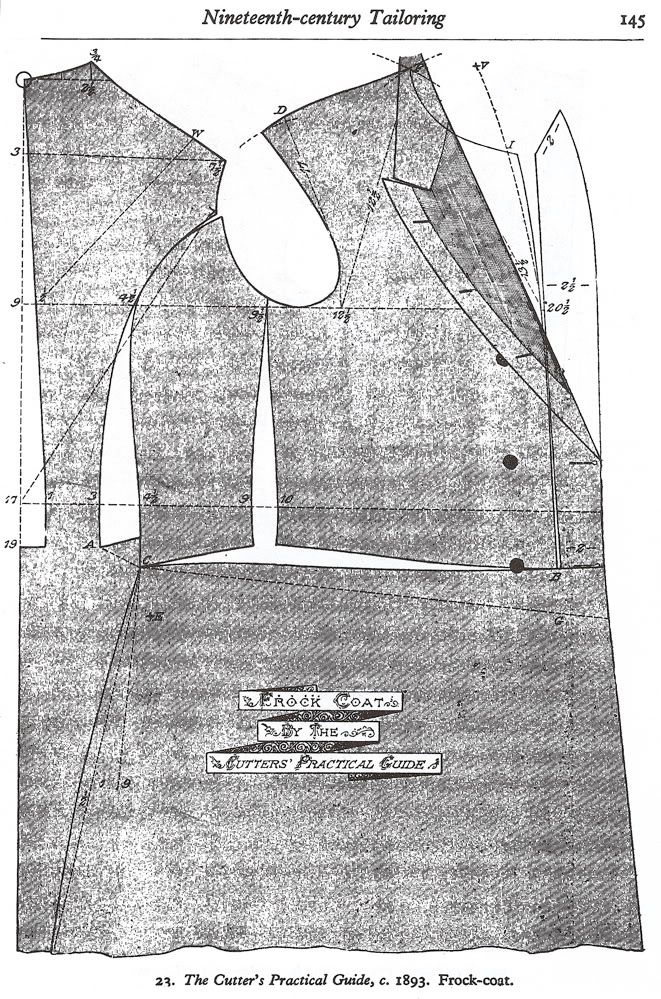
We will discuss this c1893 pattern in detail below. Otherwise, this pattern and a picture of the overall look are all most tailors will require:
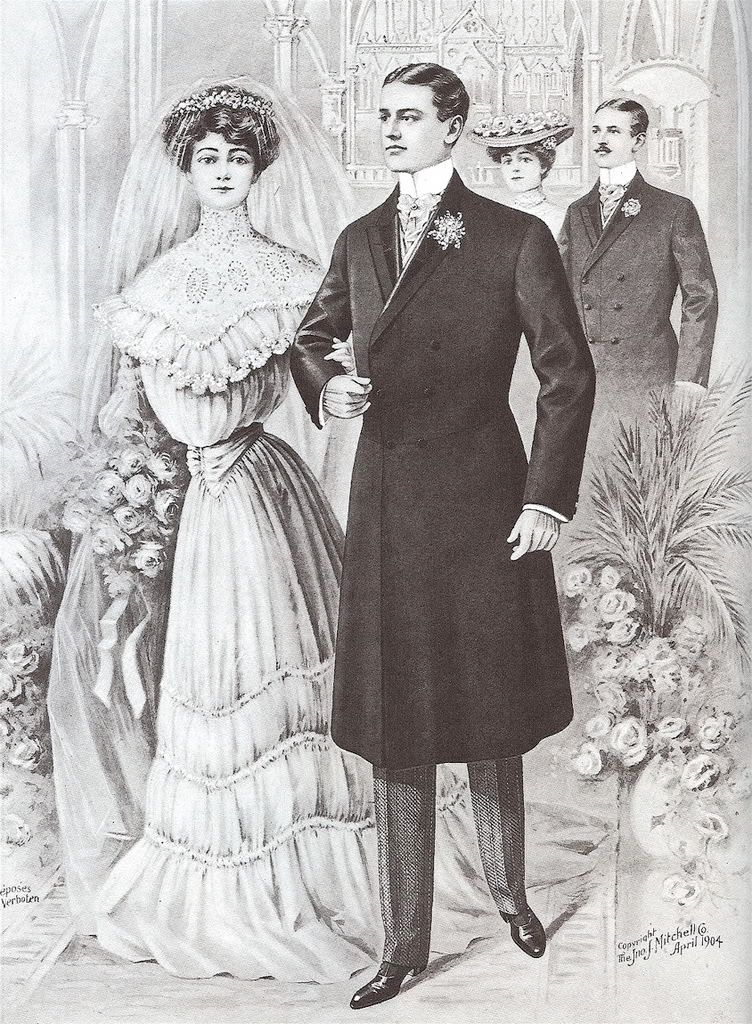
This is how a frock coat looks from behind:
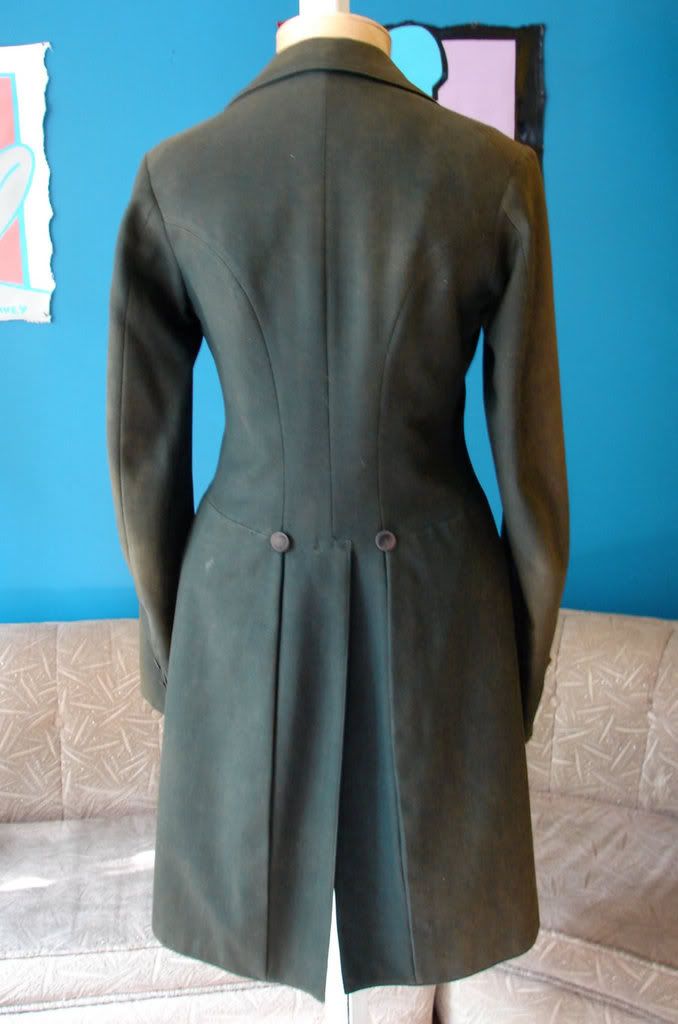
The interlocking rear panels are common to all body coats (morning coats, dress coats), as are the two largely decorative buttons at the back. Tell your tailor that a frock coat is basically cut like a double breasted morning coat without the cutaway front.
Now, there are just a few issues of style to be discussed.
Whole Cut vs Separately Cut Lapels
One interesting detail is the separately cut lapel in the above tailor's pattern. Tailors at the time apparently thought that it made the lapel roll more elegantly. This is what a frock coat with a separately cut lapel looks like. Notice the vertical seam at the front of this coat:

You can see this seam on some of the other photos and fashion plates here. The c1893 shows a construction with a separately cut lapel.
Here is an example of a whole cut lapel without the seam:

Here is one of my waistcoats on which my tailor (Sam Disano) has cut the lapel separately:
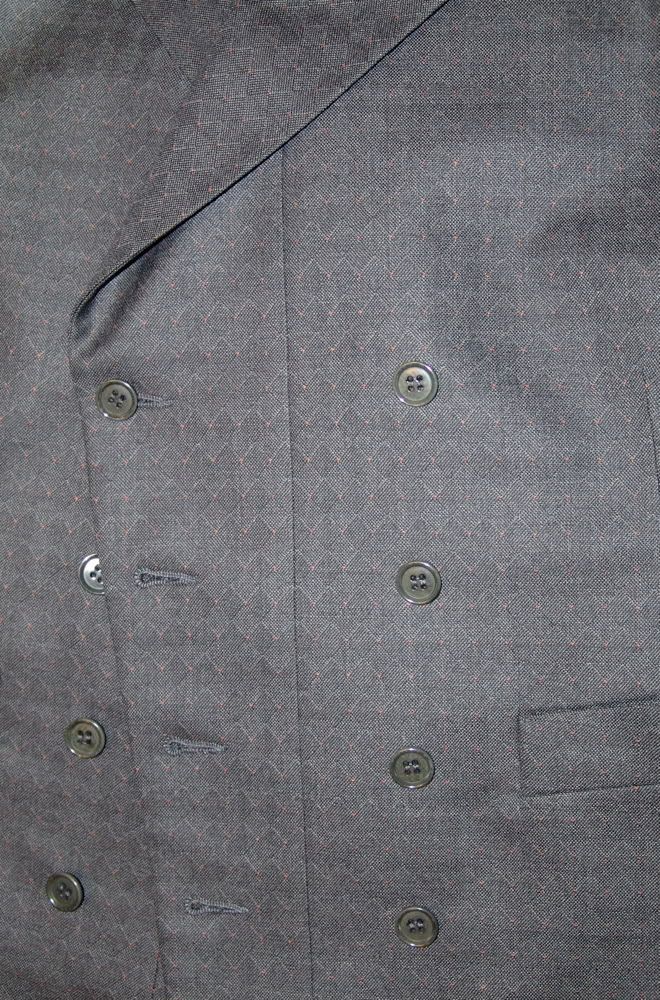
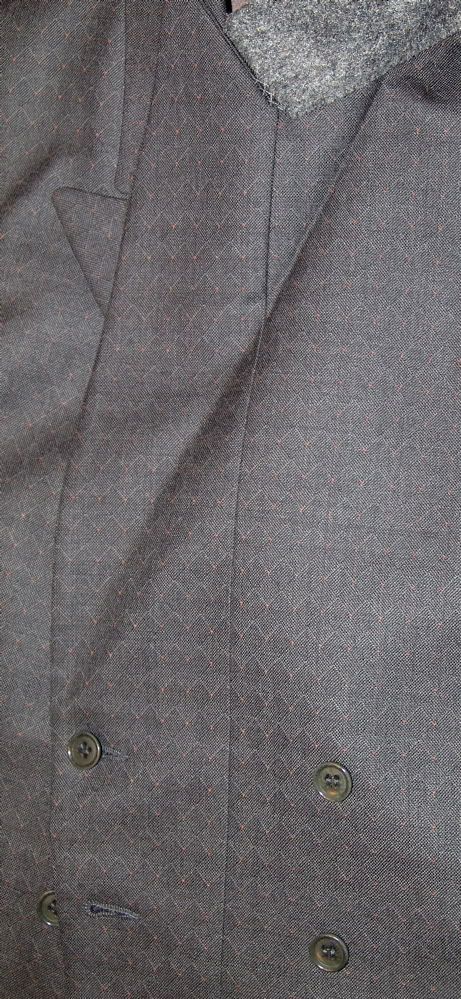
Having the lapel cut separately will add greatly to the complexity of the construction - and raise costs once again. You will have to beg, plead and insist on this detail if you want it.
Grosgrain Facings
I would mostly likely ask for grosgrain facings on the lapels like on a dinner jacket or dress coat. You can see this on the c1893 pattern.
Notice how on this frock coat the ribbing on the grosgrain is cut at a really striking angle parallel to the lapel:
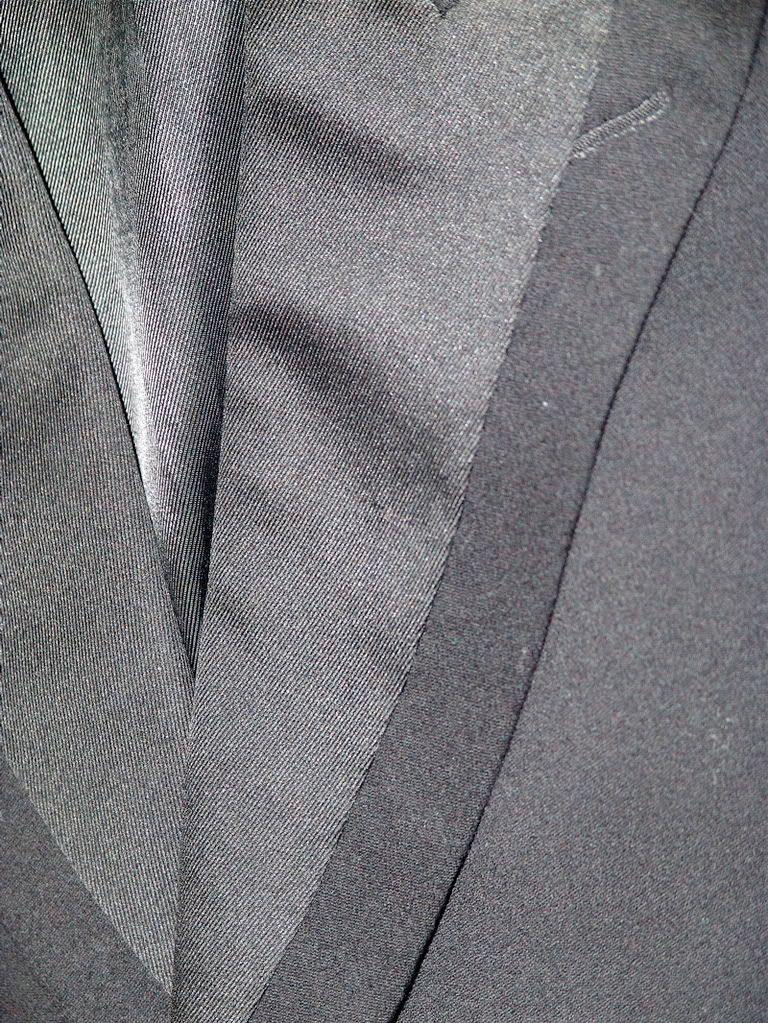
Isn't that absolutely dashing! Compare this with the rather mundane, horizontally placed ribbing on a modern dinner jacket:
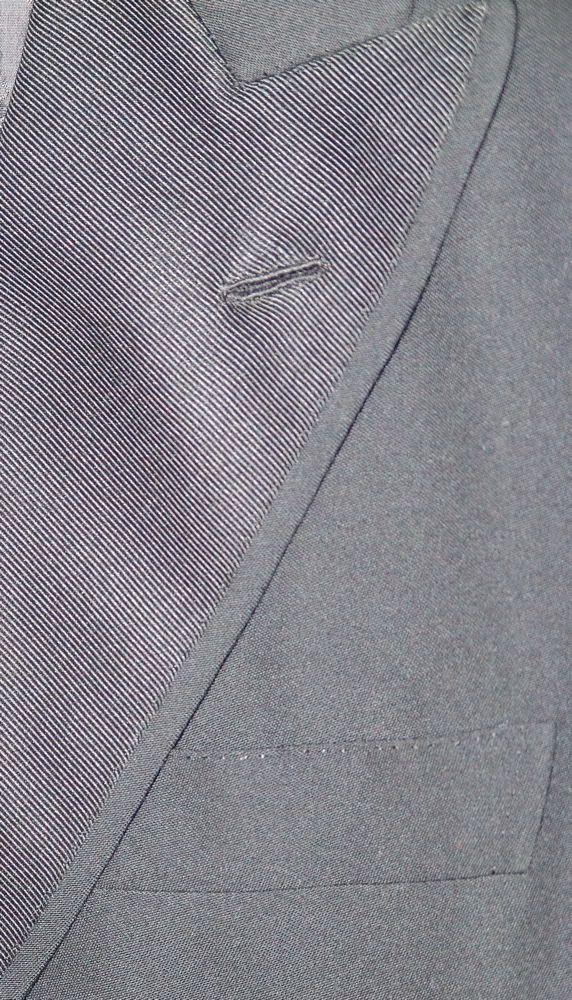
Lapel Buttons
The row of three lapel buttons going down the lapel edge in the c1893 tailor's pattern, (rather than just the modern single lapel button hole) is very old fashioned. The row of extra lapel buttons is just decorative. Here is an example from around the 1860-70s with two decorative lapel buttons:
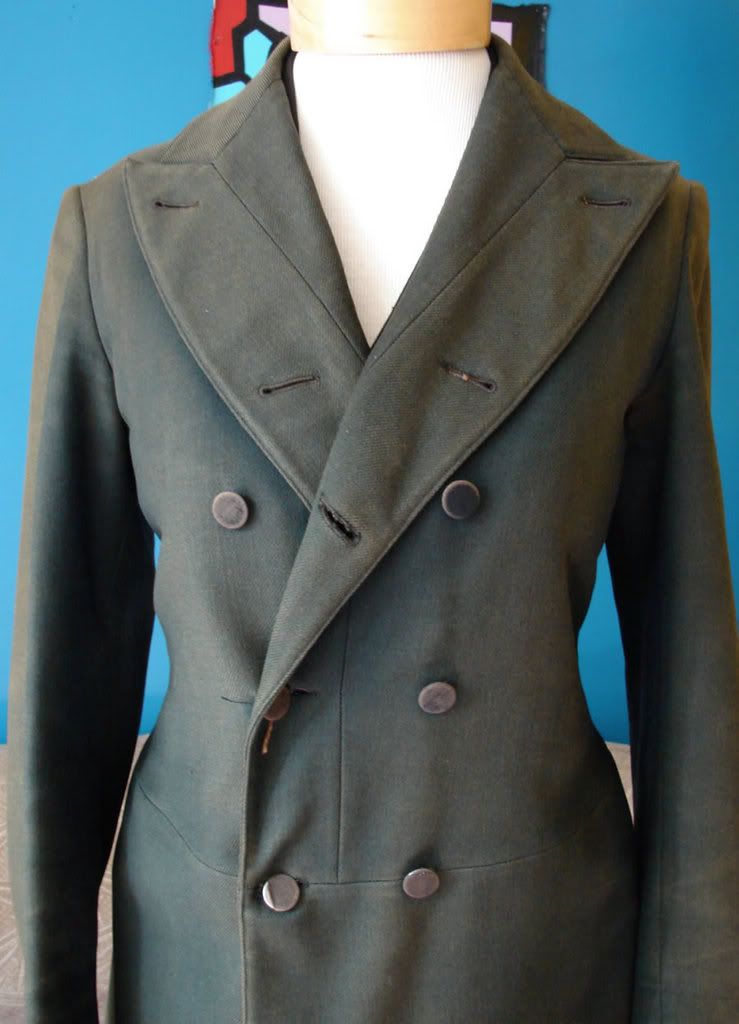
Towards the end of the 19th century the extra decorative lapel buttons started to be omitted:

Early 20th century frock coats are like modern lounge coats in that they have only the one lapel button. I think that it is unusual enough to have a frock coat without having all of this 19th century detail, which largely disappears by the end of the 1890s. I prefer the more modern single lapel button. You may want to ask for these older historical details but there is a risk of it making it look like costume. Details like this also add to the cost.
Button Stance
The dressiest was classically the 4x2 coat. 8x4 was considered more informal (warmer = practical = informal). 6x3 was probably somewhere in between. The latter two also look rather old fashioned and costumey (although a 6x3 just might plausibly work).
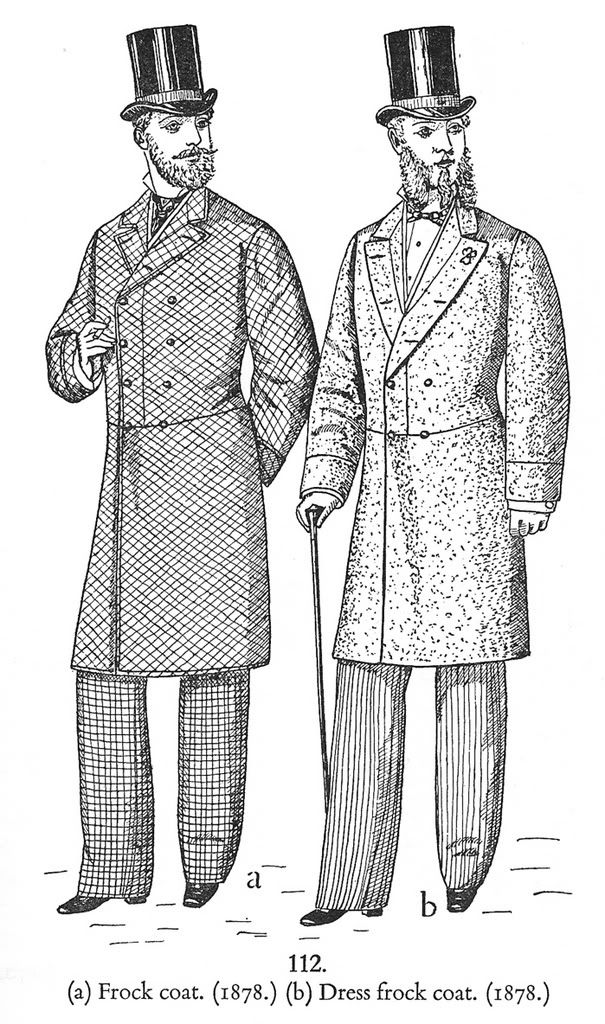
I would regard it to be acceptable to modernise the coat by having it in a 6x2 stance. The buttons should be covered in grosgrain.
High or Low Fashion Waists
The fashionable height of the waist seam went up and down during the life of the frock coat. I like a lowish waist seam and a somewhat elongated waistline myself. Choose what looks best on you. A high waist seam will make your legs look longer.
Outer Pockets
A frock coat should strictly speaking have no outer pockets at all (pockets = practical = informal). There must be NO side pockets. Traditionally, there was no chest pocket either but there was a fad (frowned upon by purists) of including one. I prefer none but it you really wanted one, Oscar Wilde sports one too:

ie this detail may be considered 'gay'.
Lining
The most traditional lining is grosgrain (the same as the lapels). However, you might want a modern fabric because silk runs hot. My vintage/antique coats have very light grosgrain linings whereas the grosgrain in the Holland & Sherry formal book is about 375g weight (silk/wool blend)! You would have to be a real purist and masochist to insist on that detail.
Waistcoat and Trousers
There was a fashion around the turn of the 20th century for frock coat suits with matching trousers and waistcoat. Purists frowned upon them even back then. I think it looks funereal, but yet for a funeral you need a frock coat with self faced lapels. It looks more like proper morning dress if you wear a lighter coloured waistcoat and formal striped trousers.
So there you have if folks - the most comprehensive overview of frock coats written for over a hundred years.
There is more to come. I will post scans of swatches from H Lesser suitable for a frock coat (and morning trousers too). Watch this space.

We will discuss this c1893 pattern in detail below. Otherwise, this pattern and a picture of the overall look are all most tailors will require:

This is how a frock coat looks from behind:

The interlocking rear panels are common to all body coats (morning coats, dress coats), as are the two largely decorative buttons at the back. Tell your tailor that a frock coat is basically cut like a double breasted morning coat without the cutaway front.
Now, there are just a few issues of style to be discussed.
Whole Cut vs Separately Cut Lapels
One interesting detail is the separately cut lapel in the above tailor's pattern. Tailors at the time apparently thought that it made the lapel roll more elegantly. This is what a frock coat with a separately cut lapel looks like. Notice the vertical seam at the front of this coat:

You can see this seam on some of the other photos and fashion plates here. The c1893 shows a construction with a separately cut lapel.
Here is an example of a whole cut lapel without the seam:

Here is one of my waistcoats on which my tailor (Sam Disano) has cut the lapel separately:


Having the lapel cut separately will add greatly to the complexity of the construction - and raise costs once again. You will have to beg, plead and insist on this detail if you want it.
Grosgrain Facings
I would mostly likely ask for grosgrain facings on the lapels like on a dinner jacket or dress coat. You can see this on the c1893 pattern.
Notice how on this frock coat the ribbing on the grosgrain is cut at a really striking angle parallel to the lapel:

Isn't that absolutely dashing! Compare this with the rather mundane, horizontally placed ribbing on a modern dinner jacket:

Lapel Buttons
The row of three lapel buttons going down the lapel edge in the c1893 tailor's pattern, (rather than just the modern single lapel button hole) is very old fashioned. The row of extra lapel buttons is just decorative. Here is an example from around the 1860-70s with two decorative lapel buttons:

Towards the end of the 19th century the extra decorative lapel buttons started to be omitted:

Early 20th century frock coats are like modern lounge coats in that they have only the one lapel button. I think that it is unusual enough to have a frock coat without having all of this 19th century detail, which largely disappears by the end of the 1890s. I prefer the more modern single lapel button. You may want to ask for these older historical details but there is a risk of it making it look like costume. Details like this also add to the cost.
Button Stance
The dressiest was classically the 4x2 coat. 8x4 was considered more informal (warmer = practical = informal). 6x3 was probably somewhere in between. The latter two also look rather old fashioned and costumey (although a 6x3 just might plausibly work).

I would regard it to be acceptable to modernise the coat by having it in a 6x2 stance. The buttons should be covered in grosgrain.
High or Low Fashion Waists
The fashionable height of the waist seam went up and down during the life of the frock coat. I like a lowish waist seam and a somewhat elongated waistline myself. Choose what looks best on you. A high waist seam will make your legs look longer.
Outer Pockets
A frock coat should strictly speaking have no outer pockets at all (pockets = practical = informal). There must be NO side pockets. Traditionally, there was no chest pocket either but there was a fad (frowned upon by purists) of including one. I prefer none but it you really wanted one, Oscar Wilde sports one too:

ie this detail may be considered 'gay'.
Lining
The most traditional lining is grosgrain (the same as the lapels). However, you might want a modern fabric because silk runs hot. My vintage/antique coats have very light grosgrain linings whereas the grosgrain in the Holland & Sherry formal book is about 375g weight (silk/wool blend)! You would have to be a real purist and masochist to insist on that detail.
Waistcoat and Trousers
There was a fashion around the turn of the 20th century for frock coat suits with matching trousers and waistcoat. Purists frowned upon them even back then. I think it looks funereal, but yet for a funeral you need a frock coat with self faced lapels. It looks more like proper morning dress if you wear a lighter coloured waistcoat and formal striped trousers.
So there you have if folks - the most comprehensive overview of frock coats written for over a hundred years.
There is more to come. I will post scans of swatches from H Lesser suitable for a frock coat (and morning trousers too). Watch this space.
Other good sources for turn-of-the-century frock coat patterns include "The Art of the Tailor" by Robert Doyle, available from Sartorial Press Publications; and "The Blue Book of Men's Tailoring -- Grand Edition of Supreme System for Producing Men's Garments" by Frederick Croonborg, available in reprint from R L Shep Publications.
That separately cut lapel Sator mentioned is there to help produce a "round chested" effect which was considered fashionable in the mid- 19th century. A clever tailor may cut the facing so the seam appears only on the body, not the lapel. Or the lapel seam may be replaced by a pair of darts on the button line.
I can't speak for European coats, but the most common mid-19th century lining in American frocks is alpaca. Don't know if it's still available today.
Hope this is useful,
Jim Ruley
That separately cut lapel Sator mentioned is there to help produce a "round chested" effect which was considered fashionable in the mid- 19th century. A clever tailor may cut the facing so the seam appears only on the body, not the lapel. Or the lapel seam may be replaced by a pair of darts on the button line.
I can't speak for European coats, but the most common mid-19th century lining in American frocks is alpaca. Don't know if it's still available today.
Hope this is useful,
Jim Ruley
Applause to all the contributors and the fine young man who started this thread. I am a huge historical dress fan though not only of western clothing. I definately would get in on the fun but practicality and my rational mind do not allow me such pleasures. I have thoroughly enjoyed this thread and can't wait for the updates. Thank you, again.
Stephen In Atlanta
Stephen In Atlanta
-
- Information
-
Who is online
Users browsing this forum: No registered users and 46 guests
